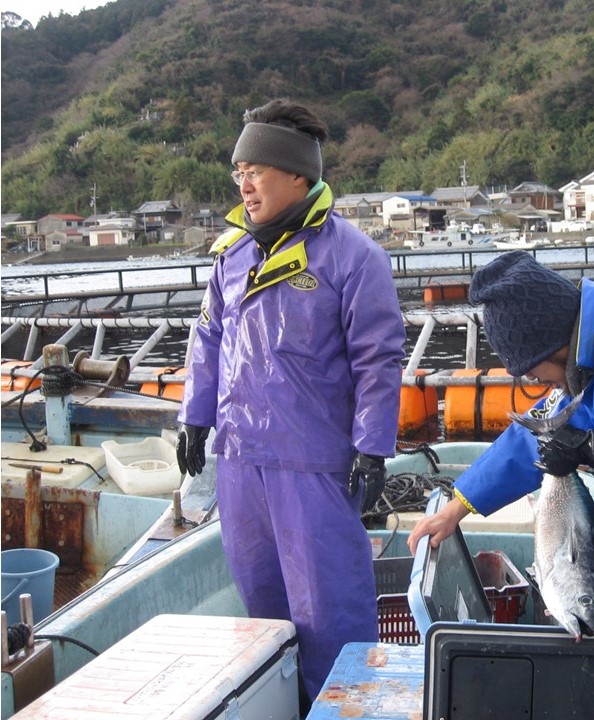Exploration of functional properties of insects as sustainable feed ingredients for fish aquaculture and development of technologies for their utilization.
※The content is current at the time of writing.
Insects as a food resource for the next generation
Research Overview

As the world population grows significantly, fish farming, which supplies mankind with animal protein, is becoming increasingly important, and its production is increasing significantly worldwide. In Japan, marine fish farming is thriving, and Ehime Prefecture boasts the highest fish farming production in Japan. However, the cultivation of carnivorous fish such as sea bream, yellowtail, bluefin tuna, and eel, which is widely practiced in Japan, requires the use of fishmeal derived from edible anchovy and many other natural fish as feed, the amount of which is several times larger than that of cultured products. This fact poses a major problem in terms of environmental impact. To overcome this situation, it is essential to develop alternative protein sources to fishmeal.
Most fishmeal reduction efforts are dominated by the use of vegetable protein to compensate for the reduction in fishmeal. When replacing fishmeal in feed for carnivorous fish such as yellowtail and sea bream, which are the mainstay of marine aquaculture, with plant materials such as soybeans or corn gluten, it is necessary to consider the difference in amino acid composition between animal and plant proteins.
Experimentally, it is possible to replace fishmeal in aquaculture feed with vegetable protein by supplementing with essential amino acids and the amino acid derivative taurine. However, in actual aquaculture, the use of vegetable protein-based aquaculture feed causes increased disease in farmed fish and significant individual differences in growth, and there are many challenges to the full-scale use of fishmeal replacement feed made from vegetable protein.
Insects are the largest animal phylum, and their biomass is estimated to be more than 15 times that of the entire human population. However, with a few exceptions, insects are rarely utilized as a protein resource on the planet. With the use of fishmeal in jeopardy, it is time to seriously consider the use of insects as an alternative animal protein source to fishmeal.
We have been conducting research on the practical use of insect-derived protein source (insect meal) as an alternative feed ingredient to fishmeal, and have been developing aquaculture feed containing insect meal. In the process of development, we discovered that certain insects have functional polysaccharides that activate the immune systems of various animal species, including fish, ahead of other companies in the world. In particular, the functional polysaccharide isolated from silkworms was named silkulose, and when its effects on fish and shellfish were analyzed, it was found to be a substance with various functions, including not only improving disease resistance but also improving stress and meat quality in cultured fish. We are currently conducting research activities with the aim of widely disseminating the results of this research to fish farming in Ehime Prefecture and elsewhere.


Research Features
Our research group is unique in that we have focused on the functional properties of insects. The functional polysaccharides contained in insects, which we have discovered, act on the immune system of fish to improve disease resistance, and on lipid metabolism and the redox system to reduce stress and improve the meat quality of farmed fish, thereby contributing to the added value of insect meal.

Research Attraction
Insect meal is more than just a substitute for fish meal; it has a variety of functional properties that are unique to insects. This functionality is varied and far beyond our expectations. Encountering new functionalities stimulates our spirit of inquiry as scientists.
Future Outlook
In June 2022, an endowed course “Laboratory of Insect Feed Utilization Science” was established in the Faculty of Agriculture through a donation from Taiyo Oil Co. This laboratory focuses on mealworms, the larvae of the chironomid beetle, as a raw material for insect meal for animal feed, and aims to develop efficient production methods for mealworms, develop technologies for their use as aquaculture feed, and analyze the functional substances contained in mealworms, in order to develop a technology that will serve as the foundation for a mealworm feed production business. The goal of this project is to develop a technology that will serve as a foundation for the mealworm feed production business.

Message to those who are interested in this research
Insects, which have received little attention as a food resource in the past, are now likely to become an important resource to support sustainable food production. However, there are many issues that need to be resolved before insects can actually be widely used as a raw material for food and feed. Fundamental research from a variety of disciplines is essential to solving these problems. We believe that challenging research activities by young researchers in this field will lead to the development of environmentally friendly food production.

